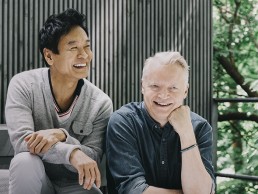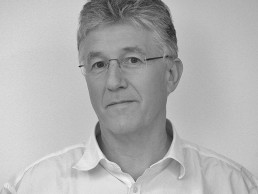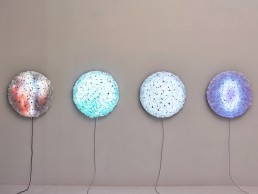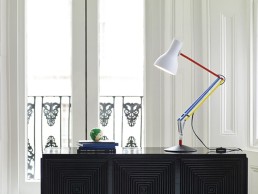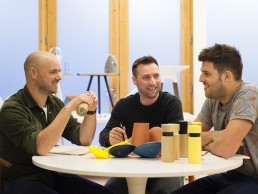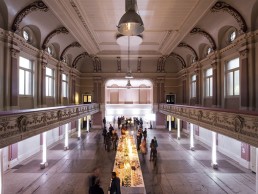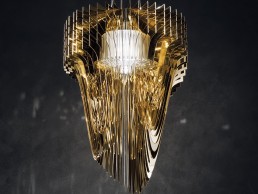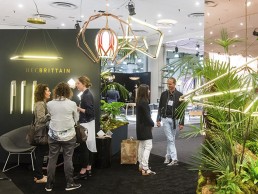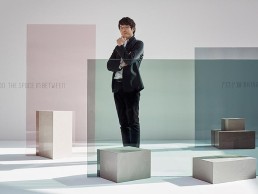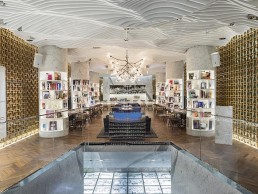Karim Rashid
Karim Rashid is considered by many as one of the most prolific designers of his generation. Over 3,000 designs in production, over 300 awards and working in over 40 countries attest to his legend of design. Here, darc gets to know the man behind the design.
Karim Rashid’s diversity affords him the ability to cross-pollinate ideas, materials, behaviours, aesthetics from one typology to the next, crossing boundaries and broadening consumer horizons.
With his work featured in 20 permanent collections, he exhibits art in galleries worldwide and is a perennial winner of the Red Dot award, Chicago Athenaeum Good Design award, Interior Design Best of Year award, and the IDSA Industrial Design Excellence award. He holds honourary doctorates from the Ontario college of Art & Design and Corcoran College of Art & Design and is a frequent guest lecturer at universities and conferences globally, disseminating the importance of design in everyday life.
Having presented at the 2016 INDEX show in Dubai, UAE, as part of the Design Innovation Forum, Rashid aimed to inspire the audience to see the world around them and the objects they interact with “in a new revolutionary light.”
“I preach about how design shapes the future and culture,” he tells darc. “I believe that design is extremely consequential to our daily lives and can positively change behaviours of humans. Products and furniture must deal with our emotional ground, therefore increasing the popular imagination and experience.
“People like to assume that design moves with more superficial trends but it is technology that drives us. Industrial design is driven by designers embracing new technologies, whether it is material, production method, or mechanical invention. So future innovation will depend on how we as designers embrace newness.
“For young designers I always give the advice: be smart, be patient, learn to learn, learn to be really practical but imbue poetics, aesthetics, and new paradigms of our changing product landscape. You must find new languages, new semantics, new aesthetics, experiment with new material, and behavioural approaches. Also always remember obvious ‘human’ issues in the product, such as emotion, ease of use, technological advances, product methods, humour, meaning and a positive energetic and proud spirit in the product. This is what is missing! Many products have a very short shelf life, and they must capture the spirit of the time in their product lines and not worry about looking, behaving and performing like everyone else.”
When asked at what point he realised he wanted to be a designer Rashid simply answered: “I don’t think I became a designer; I think I always was a designer. I realised my life’s mission at the age of five in London. I went sketching with my father in England drawing churches. He taught me to see - he taught me perspective at that age - he taught me that I could design anything and touch all aspects of our physical landscape. I remember drawing a cathedral façade and deciding I did not like the shape of the gothic windows so I redesigned them. I drew them as ovals. I also remember winning a drawing competition for children – I drew luggage (my own ideas of how to travel).”
When applying to university at the age of sixteen, Rashid found himself torn between architecture, fine art, and fashion and originally applied to study architecture at Carleton. However, too late with his application the program was full.
“They told me they could accept me in the ‘architectural stream’ of Industrial Design. So I went to Carleton University expecting to study architecture, but fate had it, that the second I took some industrial design courses I knew that was what I wanted to do.”
After University Rashid worked for seven years with KAN Industrial Designers in Toronto, Canada, designing x-ray equipment, a mammographer, power tools for Black & Decker, trains seats, 3D glasses for IMAX and mail boxes for Canada Post.
In 1991 he left Canada to teach at RISD, which would turn out to be one of the most significant moments in Rashid’s career. “I was fired from RISD in 1992. I was told I was teaching ‘philosophy and theory’, not design,” he says. “The reason is that many schools at that time were steeped in craft, not in industrial design.”
This was perhaps the spur Rashid needed to eventually open his own office in NYC in 1993. “I had no connections, no money, no one. It was really difficult, many times I thought I would just quit and become a full-time academic. But I persevered and was determined to build my own practice and be successful. It took about five years before I actually had some success in the world and now I have had my practice for 23 years in NYC.”
A second significant time in Rashid’s career was the design of a restaurant for Morimoto the Iron Chef in 2001, which won numerous awards. “Being a successful restaurant interior afforded me many more interior projects,” says Rashid. “My first condo for HAP investments in NYC opened the doors for me to design so many residential interiors and buildings. I have two in Miami, four condos in NYC, private residences in Kado, Lativa and La Jolla California.”
Talking influences, for Rashid inspiration doesn’t come from any one place or thing, but from being creative within the criteria of a project, and from functional needs and desires. “I travel constantly and get inspired usually by the unfamiliar,” he says. “So even the lost local places of industrial parks, airport hotels, alleyways in big cities, taxis in London, a gym in Hong Kong, a bathroom in Paris, a prop plane in Sweden, a cinema in Milan, a Renault in Sweden, food in Qatar, shanty towns in South Africa… Anything that is new to my senses, unusual, odd, inspires me. Beauty is in everything if we want to see it.”
Having worked on numerous lighting designs for brands including: Artemide, Martinelli Luce, Fontana Arte, Axo Light, Studio Italia, Kundalini, and Foscarini to name just a few, Rashid tells darc of his lighting experience: “Light can be very sculptural – how it throws shadows and streaks of light. I try to bring artistic form to the physical lamp. I like the idea that the light is hidden and only penetrates out of and enhances the form of my lighting designs. Light is ethereal beauty.”
And in terms of lighting within interior design, for Rashid: “Lighting should liven up a space, bring complementary conditions, move the eye and break up surfaces, bring illusion or entropy, and embellish and give richness to surfaces and materials and objects.
“I am proud of my collaboration with Artemide to design and produce Cadmo, Doride, Emperico, Nearco lamps and my most recent Solium floor lamp. I feel that these lamps have touched a moment in time, a presence of energy, of the tech organic world in which we live. My designs are a manifestation of my soul, like a composer creating music. I get really passionate about designing a pen, jewellery, perfume bottle, liquor bottle, coffee cup, as much as I do designing a brand identity, a carpet, a flooring, furniture, interior design, or a building I can shape an entire human holistic experience from the micro to the macro.
“All objects and spaces have semantic language. I believe that it is important to not necessarily over-embellish - to keep a certain truth to a product or space or building. I call my work sensual minimalism because it is not laboured with embellishment yet has a more human, more sensual connection with us.”
In five years time, Rashid will turn 60-years-old and while you might think he has conquered all, you would be wrong. When asked ‘what’s next?’ he replies: “Well there is next, meaning this year, and next, meaning five years. This year I showed a new mobile phone for SIRIN LABS, and have about four hotel designs being launched in Bergen, Norway, Amsterdam, Tel Aviv, and Hamburg. I have three buildings being completed in NYC and Miami. This year I have a new kitchen design going to market in September for Rational, Germany, new furniture being released with Skandiform, NC Nordic Care, and Materia, as well as furniture with Maiori (France), Riva1920 (Italy) Cizeta (Italy), new Pepsi bottle will be released globally this fall, several shoes and other products in Korea under my own brand, Kreate by Karim (my own brand of housewares) distributed globally, and new products with Push and Shove, EOS, Fontana Arte, and so much more!”
And by the time he is 60? The list just keeps going… “I hope to have a fashion line branded by me, a Karim perfume, a book about the design business, my own art gallery, my own coffee shop in NYC, design an electric car, design my own house on the sea somewhere in the world, have another child, create several iconic small buildings in the world, do lots more hotels (one in each major city) have my body fat down to five percent and grey hair…”
George Yabu and Glenn Pushelberg
Founded in 1980 by partners George Yabu and Glenn Pushelberg, award-winning international design firm Yabu Pushelberg is world renowned for its timeless and artistic environments. darc met up with the duo at their New York studio to talk aspirations and conquests, past and present.
With offices in New York and Toronto, Yabu Pushelberg has grown to comprise a large and talented team of interior designers, architects and industrial designers working to realise the design firm’s vision. For its many prestigious clients and projects, covering specialised retail, luxury, hospitality and restaurant sectors around the globe, the studio’s unique design vision extends beyond the world of interiors with collaborations in numerous areas of product design, allowing them to offer a full client service.
Recognised as innovators in the hospitality and retail design industries, George and Glenn have earned countless accolades for their work, including the Hospitality Design Platinum Circle Award and the James Beard Foundation Award for excellence in restaurant design. They have been named Designer of the Year by Contract, and are Interior Design’s ‘Hall of Fame’ inductees, who also named Yabu Pushelberg the ‘No.1 Most Admired Firm’ as voted by the top 75 hospitality design giants.
In 2013, George and Glenn were appointed as Officers for the Order of Canada for their contributions to design excellence internationally, notably by bringing their creative outlook to public spaces, and for promoting the Canadian design industry. Most recently in 2015, the firm was included in Wallpaper’s Power 200 list, Business of Fashion BoF 500 list – an index of people shaping the global fashion industry, and were honoured at Fashion Group International’s annual Night of Stars Gala.
At their New York office on Prince Street, SoHo, the duo chatted with darc’s Editor Helen Fletcher on how the story began and the design firm’s relationship with light…
It all started in 1972, when the two Ontario natives were brought to Ryerson University in Toronto, Canada for reasons that can be loosely linked to kismet. “I think we both had a similar view on going to school,” recalls Glenn. “For me, I looked at this design school and thought… This looks like incredible fun! The course took more of an artistic approach than many others, I had the opportunity to leave a small town and head to a big city, it was such a great opportunity.”
“I think I had the same ‘directionless direction’ as Glenn, in life when I was a little kid and I looked at the course and thought, wow no exams?” jokes George. “The greatest thing about the course was that in the first year they didn’t teach you any sort of design philosophy, you were left to explore… For me it was about picking up a camera and I chose to concentrate on photography and film making, which were both all about light; the various exposure to the different pieces of equipment to express ideas and communicate, was one of the first instances where I became aware of light.
“When I was lighting these movies with a little Super 8 camera there was something physical to consider, it was my first experience of learning about lighting and its potency.”
Post university, the pair found themselves individually working from home, both doing their own thing and looking for studio space – good timing all round it would seem!
“We ended up finding a space together and ultimately, ended up working on each others’ projects,” says Glenn, “and it eventually turned into a company. We were doing little things such as coffee shops, shoe stores and so on… We were kids playing to be honest, it was about a passion for creating things and of course the projects got bigger and better as time went on. It was like a snowball that turned into an avalanche!”
And that, was when the call from Taiwan came… “We didn’t know where the interest had come from and even had to look Taiwan up on a map having not travelled such a distance before,” continues Glenn. “The client had seen some of our work published in Japan and wanted us to design their store. So they flew us over - I remember thinking the flight would never end! This move catepulted our career in Asia.”
“One of the great adventures of that huge retail project in Taiwan was that really, at the time, we didn’t know what we were doing,” admits George, “in terms of merchandising and so on then the lighting… We learned really quickly as we had to do it all and particularly as we had gone into the project as foreigners - they entrusted us with every aspect!”
“We were young and it was an adventure and we were kind of forced to create ways of working, systems and ideas / ways of designing because we didn’t have any sort of background in it,” adds Glenn. “We always had a great time doing the projects and we always focussed on the principles of our passion for making and creating things rather than the money, but at some point you have to look at being sustainable.”
From here, Yabu Pushelberg’s reputation went on to grow at a great pace, with projects including everything from a high end residential project in Canada for a prominent art collector, which ultimately led to a theatre project working with artist Frank Stella in New York, to the Bergdorf department store and from there a Carolina Herrera store, both also in New York.
Glenn recalls the moment the duo realised studio relocation was in order: “Canada is a beautiful place but we had a desire to move to New York. We had growing staff levels in Canada and it was a great setup but we got to a point where we decided to change our lives and opened a studio in New York.
“Of course it made no economical sense and it took a while to build up, but 40% of projects we were working on were outside Canada; today, we don’t have any projects there.”
It was however, important to both to continue with a base in Canada, with George adding: “From an emotional point of view it was important to stay there and also the talent pool we have is so great. We didn’t want to let anyone go and it was all set up and with today’s tools of communication it really hasn’t been an issue.”
Some of Yabu Pushelberg’s most notable projects include the Park Hyatt New York in 2014, which offers unprecedented luxury in the heart of Midtown and is inspired by the idea of a well-appointed New York home, capturing the verve of New York City itself; FANCL Hong Kong flagship store in 2015, which was inspired by the union of nature and science through which the products are developed. The results define a real destination more compelling than the typical cosmetic shop, redefining expectations; then there is Ports 1961 Shanghai also completed in 2015, which was designed with careful consideration to reflect the transformation of the brand, while also serving as a destination for the discerning consumer.
With such prestigious projects under its belt, it’s no surprise that the design practice has become well established in Asia, the Middle East, US and Canada. But more recently it has started to make its mark on Europe, with the Printemps Voile retail project, which completed in Paris in January 2016, testimony to this.
Yabu Pushelberg was challenged with the task of re-establishing the core of the iconic Printemps department store. Instead of relying on a cupola to draw the eye upwards, the new architecture of the space upends the notion of a traditional atrium.
A ‘sail’ effectively filling the void was devised along a parabolic curve, engaging visitors as the relationship with the physical space changes whether ascending or descending within its volume. Extending seven storeys through the centre of the store, the vertical, curvilinear arc was established as a visual devise, drawing shoppers upward.
The ‘sail’, a transparent perforated metal panel, was suspended in a parabolic curve opposite the escalators. Drawing inspiration from the original stained glass domes iconic to the store’s 1865 architecture, the form is punctuated with the seemingly random, though highly studied placement of petal-shaped coloured dichroic glass pieces. Light, filtered from above, plays with the volume creating an ever-shifting, vivid statement. Back-painted one-way mirrored glass opposite the installation reflects pattern and light, producing a completely immersive expression of light and colour.
Describing himself as a ‘closet lighting designer’ for George, when working on a project, it is interesting to consider who will be using the space, or stay in the hotel, it’s not just about the function of the space but how it appeals to someone.
“Maybe it’s a component that’s so seductive and can make the environment so seductive that you start realising even more so, the finer precision required for the lighting,” he tells darc. “Using lighting to paint surfaces… That’s one of the hardest things to explain to clients because it’s not so tangible.”
While Yabu Pushelberg does work with lighting designers on some projects – with the pair admiring the work of Isometrix’s Arnold Chan in particular – they have their own, very specific views on how lighting should be. “For me the key elements are highs and lows,” says George, “physically, I like lighting sources from different heights, not just from the ceiling or table lamps. I hate seeing the source of light – I don’t want it glaring in people’s eyes or hotspots when people are taking photographs.
“I learnt a lot from Arnold, particularly when we were invited to see the Richard Gluckman Picasso museum in Malaga. It was a building restoration project as well as an extension. Arnold painted it so romantically and almost, in some parts - such as Picasso’s studio – perfect precision lighting, it had an air of evenness to it - it was magical! You couldn’t tell straight away where the light was coming from, but you felt it.
“Later that evening at the gala event nearby Arnold had lined tents in black stretched fabric so the whole interior was black with white table cloths on tables of all different shapes and sizes,” continues George. “In the middle of each table was a stainless steel mirrored tray and there were thousands of candles throughout the room, lit against the black interior. I think there were two giant antique chandeliers but that was the only artificial lighting… Everything was shimmering vertically all over the place and you didn’t know where the horizon was. It was so simple but really stunning.”
“That experience has given us inspiration for lighting a gallery space,” adds Glenn. “We’ve not got round to doing one yet but when we do, we will have a very clear idea of how we want to do it. That museum and event was so architecturally beautiful and we feel that many of today’s museums are way too expressive for the art and what’s being exhibited there. We feel that if you can make something that’s pure, clear and strong and still have a point of view through the lighting and the proportion of spaces, how you move through the space and so on, it’s a much better approach.”
Turning their thoughts to collaborations and product development, in terms of lighting at the time of writing (July 2016) Yabu Pushelberg were working with Czech manufacturer Lasvit on a huge bespoke crystal, measuring three-metres in height, for a Four Seasons Hotel in Kuwait.
“We started working on this project about a year ago,” Glenn says, “we had this notion of doing the largest crystal possible hanging from the ceiling, projecting light onto it so it splashes on the floor and so on because we have this crazy, triple height space to play with.
“Lasvit is making the crystal in pieces… I think we’re going to be working with them a lot more moving forward on some more experimental stuff. They’ve got a great energy and strive for creating new things, coupled with all the history behind them.”
Another lighting brand of interest to Yabu Pushelberg, is Rich Brilliant Willing, based much closer to home in Brooklyn, New York.
“They do some great bespoke stuff,” continues Glenn. “It’s really clean, well crafted, honest, simple lighting that has a presence about it when you want it and doesn’t when you don’t need it as much, they do some really nice work.”
The design duo are also working on their own exclusive range of lighting, which when speaking with darc, they were hopeful of launching during Milan Design Week in the not so distant future. “We’re looking at bringing lighting design in house more and more,” Glenn explains. “There are some really good lighting designers out there but they are really busy. Plus George has such great sensitivity to light and lighting that we might as well do it ourselves.”
Alongside these lighting desires, moving forward for Yabu Pushelberg, the future continues to look bright, particularly as they advance their position in Europe. “Before you know it, people are going to be looking at us and saying ‘Oh, I thought they were an interior design firm… but look, they’re doing all of this wonderful product’. We feel the industry will see a big shift come 2017. We like to be influencers in projects and one of our ambitions is to influence all of the peripheral things around us. What is the music? What kind of restaurant is it? What uniform are the staff wearing? That’s what is interesting to us… It’s about creating the full package, providing the complete product. It’s more fun, it’s better and creates more variety.”
Nick Hoggett
With experience in both architectural and decorative lighting, Nick Hoggett of dpa lighting consultants joined the internationally renowned practice in 1979. Based at the Oxfordshire studios, Hoggett is now Partner at the practice, standing at the forefront of its progression and international achievements. darc caught up with the British lighting expert to find out how he sees the two worlds of decorative and architectural lighting moving alongside each other and how their values are gradually shifting.
In many of dpa lighting consultants’ hospitality projects, both architectural and decorative lighting are equally important. While Hoggett sees decorative lighting as becoming ever more important, the need for both remains; architectural and decorative lighting are interdependent.
“You need linear LEDs and beautifully integrated downlights, while at the same time, we are working ever harder to use decorative lighting to do a job of work, rather than just serving as a pretty object,” Hoggett tells darc. The technical functionality is needed across both to varying extents, while maintaining their own aesthetic purposes.
Previously the consensus had been that decorative lighting was nothing more than pretty fixtures. Yet, even though there have been technical developments in the area, for Hoggett there remains a clear distinction between decorative and architectural.
“The two main architectural tools are linear LEDs and recessed downlights, and you can use those in hundreds of different ways. To me, architectural lighting is something you’re trying your hardest to hide and obviously it’s the opposite with a decorative fixture. The function decorative fixtures have is changing, but as a product there is still a clear distinction, 99.9% of the time.”
The degree of importance between decorative and architectural lighting can also vary a great deal depending on the style of a project. “In an extremely architectural project based on a concept of minimal decoration, the decorative lighting may very well be minimal or even non-existent. Yet in an extremely decorative project, it may be the other way round.” And as the dpa lighting saying goes, both architectural and decorative lighting have a right light, right place and a right time.
In recent years, there has been an overriding bias in hospitality projects towards decorative fixtures. Hoggett discusses dpa lighting consultants’ work on more inhibitive work places, referring to the practice’s involvement in office projects that feature some frivolity in the lighting as part of the overall concept. “That’s definitely been a movement in the last ten years,” he says. “We worked on the fine rooms at the UK’s Foreign and Commonwealth Office many years ago – the foreign secretary’s office had these chandeliers that were the predominant feature so even then, 30 years ago, we were integrating fibre optic spotlights into the chandelier to make them functional as well as decorative. For us, decorative lighting covers such a broad cross section of things. Everybody used to have wall lights and perhaps something that matches it. Now, a mixture of fixtures is more common, emanating an eclectic use of decorative lights.”
For dpa lighting consultants, decorative lighting has always been used by the team as a more technical lighting instrument when appropriate. With an increased importance placed on decorative lighting, the practice today has greater input when working with the interior designers over the decorative lighting elements of a project, in particular, opening a conversation with them about technical input. “A lot of decorative lighting fixtures are not lamped particularly well. It’s a very big topic of conversation. You can have a beautiful decorative fixture but its lamping won’t have been considered thoroughly – it can be very hard to keep up with all the different options if you’re not dealing with it on a daily basis.”
In Hoggett’s view, interior designers and architects need to be more aware of the technology that’s involved so they can understand how the colour of the light source, not the colour of the fixture, might interact with the colour of their materials, and whether a product should be matched with a dimmable or nondimmable driver. “Manufacturers should make it as easy as possible for people who are not used to dealing with lighting every day of the week, to understand what’s dimmable and what’s not,” he says.
A project that emphasises this integration of technology into decorative lighting is the Four Seasons Hotel in Casablanca, Morocco, with a full lighting scheme completed by dpa lighting consultants. With decorative pieces from Moroccan Bazaar, Preciosa, Yellow Goat Design and Lights of Vienna as well as several locally sourced pieces, the full scheme also boasts an extensive list of architectural lighting features. The combination of neutral small scale and visually inert architectural lighting equipment neatly integrated within the interior fabric, is offset from the large scaled decorative light fixtures that add presence and help to characterise the space. This project puts greater emphasis on using decorative lighting as a means of contributing to the look and feel of the spaces in addition to the interior design material palette, helping to break up the spatial aspects of the interior volume.
Another consequence of decorative lighting becoming more technical is the way practices develop lighting schemes.
“I can remember fifteen years ago sitting down as a practice with the senior members of dpa lighting and urging for more use of decorative lighting,” says Hoggett. “Obviously the interior designer and architect will have strong views – rightly so as they lead these things – but we said we wanted to have greater influence and that has now happened. As a result, this is increasing our range in how we develop lighting schemes. Creatively, I think it’s more interesting.”
Yet in terms of the time it takes from a business point of view, Hoggett feels this level of involvement is actually very demanding, as the team spend more time on each project as they become more deeply and technically involved.
The practice tends to put all lighting onto an integrated control system, which can create massive compatibility problems if not dealt with properly. This is where the team spends more time on the technical quality of lights in terms of dimmer, driver, lamp compatibility, as well as having a bigger influence over the lighting effect of decorative fixtures. “So we might be looking for fixtures to provide a gentle ambient light in a space,” says Hoggett, “or maybe we’re looking for them to have a narrow beam, focussed, punctured lighting coming from them. We are looking for them to do a job as well as look attractive.”
The push towards using primarily LED, energy efficient light sources also presents dpa lighting consultants with many technical challenges. A certain tungsten halogen lamp may be the right light source for a beautiful chandelier, yet the challenge is in finding and using the best LED for all the known reasons; in more recent projects, when asked for an energy efficient lamp option, dpa lighting consultants has been specifying Segula LED lamps.
“We have to test every lamp with the control system supplier, on every single project. We probably have 200 projects in the practice at the moment, so we have that challenge for every single one.”
With such a large number of projects, each with its own specificities in tow, the practice dives into its enormous library of lighting manufacturers, suppliers and designers in search of the right product for that specific job.
“When we have a project, we don’t just go to a certain section of suppliers or go to particular brands that worked on a different project,” says Hogget. “We say we’re looking for something specific and then we go to the library and research what we’re looking for rather than a product name. Sometimes, if you have certain ideas, you might gravitate towards certain manufacturers that you know fit that idea, but in general, our approach is to consider the whole library.”
With such extensive experience in the industry, Hoggett has developed ideas around how he sees decorative lighting continuing to develop in terms of product design given the latest technological trends in the field. Speaking as a materials enthusiast, but self-proclaimed ‘non-expert’, Hoggett tells darc that with new materials coming in, designers and manufacturers will be able to produce different shapes and forms that are more organic.
“3D printing has changed the world a little bit, and I think we can continue to get more complex organic shapes. They are already there and can only continue to create more interesting forms.” With a fascination for the lightness of carbon fibre, Hoggett expressed his enthusiasm for its ability to create beautifully thin, visually sharp edges, alleviating structural problems induced by heavy fixtures.
“You can get some amazing shapes and I’m sure decorative lighting will evolve with material technology. OLED will become more affordable and more useful in the future and we’ll have a lighting component that can create different shapes. These things are already starting to be there but I think they’ll come down into the masses.”
In an age where technology advances so quickly, decorative lighting is not likely to be left behind. As Hoggett outlines, changes are already taking place and the area will continue to develop, allowing decorative lighting manufacturers and those who use their products to be ever more creative.
“On the whole, decorative lighting manufacturers are doing some fantastic work; we’re lucky to be able to look at what they do and use it in our projects. I think there should be a level of praise for that,” concludes Hoggett.
And praise there is; from the variety of creative installations to the intelligent designs that carry lighting towards the forefront of interior design, the job of decorative lighting is irreplaceable and it’s finally getting the recognition it deserves.
New lights from Aqua Creations
(US) – Aqua Creations introduces Lucky Lamp and Simon Says Suspended as part of the firm’s Albi Serfaty’s collections.
As an aesthetic yet functional extension of the existing Mimosa collection, Lucky Lamp blends Aqua’s signature craftsmanship with groundbreaking technological innovation. Formed into a contemporary circular form, Lucky Lamp features a polymer-sprayed shade that uses laser cut technique.
Unique to this lamp is a technology of addressable RGB LEDs, where each light is controlled by a micro-computer to alter colour, motion and intensity. This technology enable Lucky Lamp to display five motion-lighting variants – Kaeidoscop, Fire, Water, Earth, and Wind, made adaptable with Warm, Natural and Cold colour temperatures. The 920 LEDs enable both the colour and motion options to be dimmable from 0.1 to 100%.
Simon Says Suspended is the latest addition to the Mino Collection, a line characterised by streamlines, geometric shapes. Also available as Simon Says Yes, No and Maybe, Simon Says Suspended can be hung individually or combined in different compositions of sizes and colours. The lights are created using clean lines of silk draping framed by mahogany wood or oak to provide a modernist aesthetic that ties with the overall collection. The lights are sculpted on a specially developed vacuum formed polycarbonate shell, lit with LED lamps.
Lucky Lamp and Simon Says Suspended are currently on display at Aqua Creations’ recently opened SoHo NYC flagship showroom, located at Aqua Gallery in New York.
Founder of Aqua Creations Albi Serfaty: “My idea behind the Lucky Lamp was to create a light that has multi-faceted applications. It can be used as a piece of art and as a provider of light, content and movement, as well as a very simple, yet interesting object of interior décor. For the Simon Says Suspended, I was deeply inspired by organic philosophy and the idea to create a framed straight line object that truly embodies both modernism and creativity.”
Anglepoise and Paul Smith collaborate
(UK) – Edition Three Type 75 Desk Lamp marks a third collaboration between Anglepoise and Paul Smith.
With its primary colour palette and angular Anglepoise form, Edition Three evokes the visual vocabulary of Dutch painter Mondiran’s De Stijl style of art and launches to coincide with the run up to next year’s De Stijl centennial.
Available at the start of the festive season, Edition Three complements and contrasts the floral hues of Edition One and the jewel-like tones of Edition Two with its hundred-year-old colour palette made to look dynamic and contemporary.
Simon Terry, co-owner of Anglepoise said: “Paul Smith’s remarkable ability to reimagine and then reimagine again is a testimony to his unique way of interpreting the world around us.”
Paul Smith said: “The wonderful thing about having the opportunity to work on another Anglepoise lamp is that the two editions I’ve done up to now are almost like a winter and summer version – one in dark rich colours and the other in brighter pastels. What I’ve decided to do this time is take inspiration from the artist Mondrian and use accent colours of white, red, yellow and blue.”
The Anglepoise + Paul Smith Type 75 Desk Lamp – Edition Three will be available to buy in October 2016.
designjunction supports dyslexia
(UK) – The inaugural Dyslexic Design curate exhibition will take place during designjunction 2016.
Dyslexic Design will explore the connection between dyslexia and the creative industries. The project, in support of the British Dyslexia Association, is to celebrate dyslexic designers’ work over five days during London Design Festival.
Curate by UK designer Jim Rokos, Dyslexic Design will challenge perceptions of dyslexia by accentuating the positive effects of living with dyslexia and its close association with design in a bid to remove the stigma sometimes associated with it.
More than ten leading designers from multiple design disciplines including product, fashion, illustration, home décor and fine art – all of whom are dyslexic – will showcase their work in a temporary curated exhibition at designjunction. Confimed designers include, Sebastian Bergne, Terence Woodgate, Kristjana S Williams, Tom Raffield, Tina Crawford, Rohan Chhabra, Vitamin and Jim Rokos.
For the first time, many of these designers will talk openly about the challenges they face in their career paths, with many of their work also demonstrating unusual three-dimensional thinking.
Throughout the show, which will be at Granary Square at King’s Cross this year – critical debates on design education, the relationship between dyslexia and lateral thinking, and the relationship between dyslexia and visual thinking will take place. Questions will be realised about if we could make our world more user-friendly for a dyslexic, and whether it would be appropriate to declassify the less common brain structure as a disability.
“It is my belief that I am able to design the way I do, because of my dyslexia and not despite it,” said Dyslexic Design exhibition founder Jim Rokos. “I also firmly bleive that other dyslexic designer have idiosyncratic styles because of their dyslexia.
“I am delighted designjunction shares my vision and desire to remove the unwanted and unwarranted stigma sometimes associated with dyslexia and in doing so change perceptions of it. We believe dyslexia is something that drives and inspires creative thought and design”
designjunction’s Managing Director Deborah Spencer added, “This is a subject matter very close to my heart. I had grown up with dyslexia and I believe it played an integral part in leading me down the path of art and design. In some respects this has defined me as a person. It is a great pleasure to support this brilliant project.”
Media 10 launches LuxuryMade
(UK) - Events company Media 10 launches new decorative show LuxuryMade as part of London Design Festival 2016.
LuxuryMade focuses on the high-end interior design market, showcasing lighting, accessories, fabrics and furniture from 50 brands. The new show will take place across two spaces; The Pillar Hall banquet room with Corinthian columns, and Upper Pillar Hall, which was once the UK’s first electric cinema.
Both spaces were constructed as part of the original Olympia site opened in 1886 as the ‘Princes Apartments’. LuxuryMade will play a central part of a new West Kensington design district, alongside Design Museum and 100% Design in 2016.
Event Director William Knight commented: “The launch of LuxuryMade marks an exciting moment for Media 10, the London Design Festival and the luxury interiors community.
“By staging a beautifully produced and highly selective showcase of some of the best contemporary and decorative brands in a stunning central location, it responds to an expanding market in need of a new high quality event and visitor experience.
“We have placed this ambitious show within the emerging powerhouse of design in West Kensington – alongside the new Design Museum and 100% Design.”
Set across two spaces within one venue, LuxuryMade will take place in Olympia's Pillar Halls, part of which have been hidden from public view for over 20 years.
The Pillar Hall is an extravagant banquet room with ornate marble Corinthian columns and intricately embellished ceilings. The high arches of the Upper Pillar Hall, which was once the UK's first electric cinema, will serve as the second space.
Both halls, constructed as part of the original Olympia site which opened in 1886 as the 'Prince's Apartments', demonstrate the grandeur of Victorian architecture and subsequently, provide the ultimate venue for this event.
London-based international studio Maddux Creative will be responsible for the aesthetics of the show's interior. Experts in bespoke interior design, this collaborative force of interior designers and architects, is headed up by design duo Jo leGleud and Scott Maddux.
Founded in 2011, Scott and Jo have established a strong multidisciplinary design team with a shared aesthetic vision and creative sensibility. Focusing their collective skills, dedication and knowledge, they deliver imaginative and distinct design tailer-made to address their clients' specific needs and tastes.
In designing the space, Maddux Creative will forge an atmosphere representative of the diverse range of exhibitors, creating a setting aimed to inspire visitors.
Visit the show from September 21 - 24 2016.
Future plans for northmodern
(Denmark) - Starting in 2017, northmodern will cease being a biannual trade show to become an annual event with a more exclusive offering and a sharper focus on furniture.
Following northmodern in August 18-20 this year, the first annual trade show will take place May 9-11, 2017.
Kristian W. Andersen, Director at northmodern, commented: “Our vision for northmodern is clear. Together with our partners, Danish Design Centre and Design denmark, we intend to make Copenhagen and Denmark a vital global design destination once more. Over the last 3 seasons, northmodern has put forth a sharply curated offering. Going forward, we will continue to refine our focus to offer the best of furniture, lighting, kitchen, industrial design and interior design. Our aim is to propel the northmodern platform to the pinnacle of international design."
In addition to the northmodern fair, the northmodern studio construction is underway – a unique design centre dedicated to the international and Scandinavian furniture industries with permanent showrooms and a ground floor reserved for the most talented and innovative new minds of the industry. northmodern studio will also house pop up galleries, stores, a unique gastronomical area and contemporary art installations.
Together, northmodern fair and the northmodern studio will bring vibrancy essential to the growth of Bellakvarter, the unique new urban development project currently under construction in Copenhagen’s Ørestad area. As the BellaKvarter community takes root and grows, northmodern anticipates new interactions between exhibitors, residents and creative minds, making northmodern the only trade show platform with its own city.
“In short, we believe that Copenhagen’s creative industries are amongst the best in the world. What they need is a well-integrated, innovative platform that will propel them forward and enable them to thrive in a hyper-competitive global marketplace. Our mission at northmodern is to be that platform,” said Andersen.
CEO at Danish Design Centre (DDC), Christian Bason commented: “We are excited that Copenhagen and Denmark take the leadership in placing design on the global agenda. We are committed to a fruitful and sustained collaboration with northmodern.”
Managing Director/CEO Design denmark, Morten Grøn said: “As partners, Design denmark is strongly committed to take an active part in realising the vision we share with northmodern.”
Allan Agerholm, CEO, BC Hospitality Group, concluded: “Danish design is world-renowned and Copenhagen is one of the most exciting and desirable capitals in the world. It’s therefore sound business for us to invest in a solid platform to showcase the best of Danish design in a cutting edge facility combining permanent showrooms and the flexible exhibition space of the Bella Center in the middle of our new BellaKvarter.”
The next edition of northmodern will feature more brands, new talents, exciting collaborations and special projects.
Zaha Hadid Aria Gold
Zaha Hadid’s team release Aria Gold for Slamp at Salone del Mobile 2016.
Aria Transparent was unveiled during Euroluce 2015, and Aria Gold released earlier this year, just weeks after her passing.
Aria Gold is the most recent addition to the family, and is made of 50 metalised polycarbonate layers, which radiate around a central LED source. Each of the chandelier’s 50 arms is unique, requiring each piece to be made by hand.
Slamp’s Creative Director Luca Mazza commented on how Hadid merged her aesthetics with Slamp’s founding value of accessibility: “In the beginning, Zaha wanted to create an opulent, sculptural object reaching a diameter of 2.5 metres.
“We had never even considered dimensions of this kind. As we discussed it together, she immediately realised the essence of the brand, and reduced the lamp’s proportions without compromising her design identity. She sat next to me and with four masterstrokes, sketched Aria. Then she looked at me and said, ‘Now it’s your turn. Who better to illuminate an object than a lighting design company?’ I was honoured.”
ICFF heads to Miami
(US) – After successful show in New York, first ICFF Miami show set to take place from October 5-6 2016.
The first annual ICFF Miami will take place at Miami Beach Convention Centre. For the two day duration of the fair, 25,000 net sqft will house over 3,000 interior designers, architects, and manufacturers, and will be open to the public on October 6.
More than 180 international exhibitors will display contemporary lighting, furniture and interior accessories, creating a unique opportunity to view a broad yet highly focused selection of designers and their creations.
nendo collaborates with Caesarstone
(Israel) – Caesarstone and nendo unveiled ‘in the shade’, a new commission that will remain part of Design Museum Holon’s permanent collection.
As the centrepiece of the recently opened exhibition, nendo: the space in between, in the shade is presented in the external courtyard. Inspired by the strong effects of light and shadow in Israel, in the shade is constructed using a collection of five free-standing sheets of glass coloured by Glas Italia, supported by Caesartsone pedestals.
Resembling the look of natural stone, the pedestals are created using a variety of Caesarstone designs in different tonalities, whilst the glass sheets embody the overall colour palette of the exhibition.
Appearing to divide light and shadow, the unison of the quartz along with the positioning of the glass evoke the feeling of being outdoors when looking from one side and indoors when looking through to the other side.
Intersect by Lexus, Dubai
With bespoke lighting features from Lindsey Adelman incorporated into luxurious interior design by Masamichi Katayama, Intersect by Lexus brings an innovative new concept to Dubai.
Intersect by Lexus in Dubai’s iconic DIFC, is the first of its kind outside of Tokyo, a unique luxury space where people can experience what is truly quintessential of Lexus without getting behind a steering wheel. Neither a dealership, nor a traditional retail space, guests are able to engage with Lexus through food, design, art, fashion, music and technology at its inviting eatery, curated library and innovative garage.
“Intersect by Lexus, is a unique, versatile and multipurpose space. Its inspiring décor and carefully curated library makes it the perfect place for people to work remotely amidst creative, like-minded people. It also serves as a destination to relax, meet friends, grab a healthy bite, or a post work drink without the fuss,” explains Benjamin Nicholas, Head of Intersect by Lexus.
Masamichi Katayama, world-renowned interior designer and founder of the interior design firm Wonderwall, is the man behind the development of both the Tokyo and Dubai concepts. Based on the successful formula created for first Intersect by Lexus, the Dubai venue features some local touches that evoke the essence of the UAE through the beautiful white ceiling inspired by sand dunes.
“This project is not just about creating a restaurant but rather an environment,” explains Katayama. “As an incubation platform generating new innovative ideas and concepts, it has been designed to capture the feeling of a lounge, allowing people with shared values to come together and interact in a relaxed yet inspiring atmosphere.”
Intersect by Lexus is distinguished by an intricate bamboo façade that filters natural light through miniature spindle grille motifs, the same spindle grille that carries the new design direction of Lexus cars.
The first floor features a 1,850sqft eatery serving ‘feel good cuisine’ and a curated library featuring English, Arabic and Japanese literature specialising in design, art, architecture, film and travel. There is also the Crafted for Lexus boutique showcasing a collection of contemporary lifestyle items born out of a series of collaborations between traditional Japanese artisans and young designers.
Leading guests to the lower floor, a spindle grille-shaped staircase covered with hexagonal black and white tiles, resembling tire tracks, leads guest to the garage and event space. Uniquely designed with over 155 hand-painted Lexus car parts covered with reinforced glass that holds Lexus’ newest concept cars, the space gives guests the ability to understand Lexus through a never before seen artistic lens.
Commenting on the use of lighting within the design of Intersect by Lexus, Katayama tells darc: “When we designed the first Intersect by Lexus in Tokyo, we chose pendant lighting to give an intimate feel, like a living room. In Dubai, I wanted to have this kind of intimate feeling on the upper floor so I asked the same designer, Lindsey Adelman, to design the perfect size lighting for this new space.
“Her lighting design is rich with elegance and craftsmanship and this connects to the Lexus brand. It is very important to choose the lighting that enhances the space’s identity, rather than just being beautiful lighting on its own.
“With the help of a true professional the space became exactly how I had imagined it in my head,” Katayama continues. “Working with good interior designers elevates the effect of the space. We also worked with lighting designer Masaki Yasuhara of Plus y lighting planning office, from an early stage, explaining what kind of lighting effect we wanted. He then explained how we could achieve it.
“The lighting at Intersect by Lexus brings depth and different expressions,” says Katayama. “I’m often asked which material I would choose if I could pick one and I always say lighting.”
Reflecting on the project, for Katayama his design intention was well expressed, was unique, beautiful and strong. “Each project is so different, nothing is ever the same. Here, the upper floor ceiling has a lighting system with the shape of desert dunes that is more like a sculpture,” he says, “and the lower floor has a beautiful car-parts floor with lighting. These are stand out features for me and I believe this space has become a one of a kind.”

